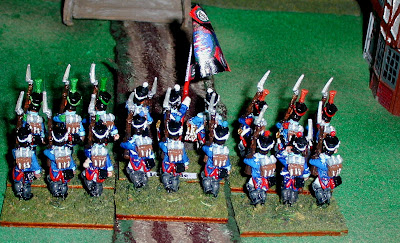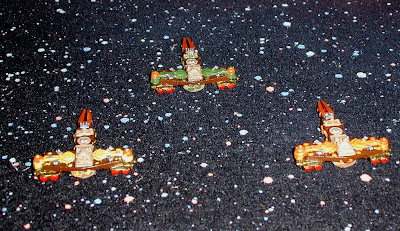It is mid October, 1812, and the French army has been marking time in Moscow after their partial victory at Borodino the previous month. Czar Alexander shows no signs of negotiating with Napoleon, and the word is that a decision by the French to retreat seems imminent. Thinking that his opportunity to pay back the hated French Emperor for his humiliation and down-sizing of his Kingdom following the Treaty of Tilsit in 1807, King Frederick-Wilhelm II of Prussia quietly issues the instructions to begin recalling the cadres of trained men discharged from the army over the past 5 years under the so-called Krumper system. Still uncertain as to the eventual fate of the French army, he explains this as readying replacements for the Prussian Auxiliary Corps, that has been enthusiastically assisting the Grand Armee against the Russians; "Plausible Deniability", and all that!
Prussian Reserve Infantry in the "regulation" grey uniform of Spring, 1813 (by Knoetel)
As
Koenig of my own 28mm Prussian army, the Fall of 2012 is time for me to expand those forces in preparation for the 200th anniversary battles of 2013. Like the historical sovereign, almost all of this expansion will take place in the form of the new Reserve and Landwehr Regiments. Being on the thrifty side, and liking their models in general, especially the Infantry, this will be done using Old Glory Figures and the Army Card Discount. The existing units in my Prussian Army are:
Line Infantry
1st E. Prussian #1 Old Glory March-Attack
1st Pomeranian #2 Old Glory March-Atttack
2nd E. Prusian #3 Old Glory March-Attack
1st W. Prussian #6 Minifigs Advancing
2nd W. Prussian #7 Minifigs Advancing
Colberg IR #10 Old Glory March-Attack
1st Silesian #11 Minifigs Advancing
2nd Silesian #12 Minifigs Advancing
Landwehr
3rd E. Prussian LW Old Glory March-Attack
3rd Pomeranian LW Old Glory March-Attack
4th W. Prussian LW Old Glory March Attack
4th Silesian LW Old Glory March Attack
Light Infantry
Silesian Schutzen Calpe Firing
Freiwilingen Jager #1 Mnifigs Firing
Freiwilingen Jager #2 Minifigs Advancing
Elites
Silesian Grenadiers (9) Minifigs Advancing
Guard Grenadiers (16) Minifgs Advancing
Cavalry
Konigin Dragoons #1 Old Glory
1st W. Prussian Dragoons #2 Old Glory
1st Leib Hussars #1 Old Glory
Freikorps von Lutzow Minifigs
Guard du Corps KR #3 Old Glory
Brandeburg Kurassier #4 Old Glory
Artillery
Horse Battery Old Glory
12# Battery Old Glory
2 x 6# Foot Batteries Old Glory
Generals
2 x 2, 6 x 1 Old Glory
16 Infantry = 279, 6 Cavalry = 48, 4 Artillery = 24 crew/8 guns, 10 Staff
GRAND TOTAL (Painted only): 361 figures
Thus the Prussian army is less than half the size of my Russians, and barely a third as large as my Austrian and French Armies. "
Unzulaenglich! mutters
der Koenig. I'd like to have 1 Regular Line, 1 Reserve, 1 Landwehr, and one "special" unit for each Prussian "Brigade" (more or less equivalent to a Division in other armies of the time. The "special" unit may be volunteer Jagers, Schutzen, or Grenadiers. Thus I will need to add eight units of Reserve and four Landwehr; I'd also like to flesh out my small Grenadier unit to at least 4 stands (of three each), if not 6. Finally, I have 16 figures of the Old Minifigs Prussian Guards with the tall, wide 'busch" plumes (found for me at a Historicon Flea Market almost 10 years ago by Joe), and will need to add a couple of command figures to round them out; these might come from Lancashire Games. I'll also need some more cavalry, especially Landwehr/National Cavalry regiments, and definitely some additional artillery units.
Anyway, using Old Glory packs (30 Infantry, 10 Cavalry, 20 artillery crew), here's what I'd have in mind:
Quantity Catalogue # Description List Price Cost
2 (60) PXI-06 Reserve Landwehr w/command $35 $70
1 (30) PXI-07 Militia Men with command $35 $35
1 (30) PXI-08 Reserve Inf British Shako w/command $35 $35
2 (60) PXI-05 Silesian Landwehr w/ Command $35 $70
1 (20) PXA-01 Prussian Foot Artillery Crew $25 $25
1 (20) PXA-02 Prussian Horse Arti llery Crew $25 $25
1 (10) PXC-08 Line Lancer Command $35 $35
1 (10) PXC-09 Line Lancers Charging $35 $35
1 (10) PXC-10 Silesian Landwher Cavalry w/ Cmd $35 $35
1 (10) PXC-12 Prussian LW Cavalry Stovepipe w/cmd $35 $35
1 (6) NXG-21 Six Prussian Cavalry Generals $25 $25
That comes to $415, but with the 40% discount, just $249 plus the $50 for the Army Card or roughly $300 plus shipping and then I'll need some guns, which will be Sash and Saber. The investment in the Card is well worthwhile, as I plan on buying a lot of OG British before it expires, in preparation for our 1815 projects! For that, I'll get 180 infantry, 40 Artillery crew, 40 Cavalry, and 6 Generals - 266 figures! Hard to beat that.
All the Cavalry will be in units of 8 (the extra 2 figures from each set will probably be used to make a really rag tag 5th (LW) unit, each stand with a different uniform style! Half of the Infantry units will be 12 figures, the other half 18 (I only need 12 figures per unit for Field of Battle) making 8 Reserve (including one in blue and one in a green "rifle" style British provided uniforms) and 4 Landwehr units. All the Artillery will be 2 stands of three, except a single 12# Foot battery, making six more artillery units.
Some good sources for the varying and varied uniforms of the Reserve Regiments (which often varied by battalion) include
The Napoleon Series, and an old Almark book (published 1972) on the Prussian APrmy of 1808-1815 by David Nash in my collection. The Osprey, "Prussian Reserve, Militia, and Irregular Troops 1806-1815 by Peter Hofshroer (Men at Arms #192), while certainly useful, IMHO wastes far too much space with the author's views on the "Kruemper System", a biography of von Gneisenau, and makes little attempt to convey much detail on the admittedly confusing topic of the uniforms of the Reserve units.
Der Befreiungskrieg is about to begin... or at least painting for it!
Peter
.jpg)




























